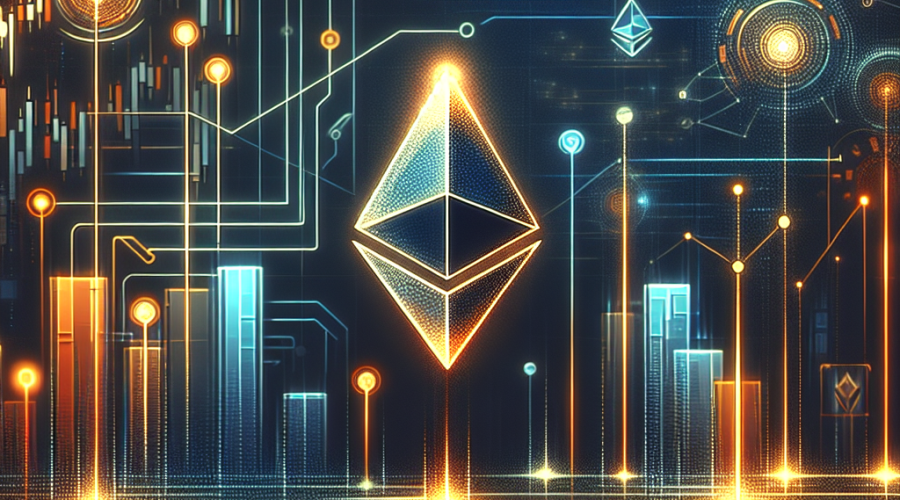The financial markets have entered a fascinating period of divergence, showcasing a strong rally in traditional equities while the cryptocurrency market continues to face headwinds. This week exemplified that split, as results from tech giant Nvidia drove American stock indices upward while Bitcoin and the broader crypto space experienced notable declines. Meanwhile, key developments in decentralized finance (DeFi), such as Aave’s ongoing growth and the evolving ecosystem of tokenized equities on Solana, add further layers to an already complex market narrative. This article provides a detailed breakdown of these trends, offering insights for both crypto novices and seasoned market participants.
Equities Surge Amid Nvidia’s Blowout Earnings
Traditional equities staged a robust rally, with the Nasdaq climbing 2.15%, the S&P 500 up 1.39%, and gold posting a 0.77% gain in a single trading session. The catalyst behind this surge was Nvidia’s much-anticipated earnings report. Defying concerns about a cooling artificial intelligence (AI) market, Nvidia beat analyst expectations mainly on the back of extraordinary demand for its data center products. The company projected fourth-quarter revenues of $65 billion, outpacing the estimated $61 billion and easing worries of an imminent AI bubble. The stock’s 5% jump in after-hours trading reflects renewed optimism across sectors closely linked to tech innovation.
Nvidia’s stellar results did more than buoy individual tech shares; they provided a psychological lift to the broader equity markets. Investors, rattled by months of volatility and recession fears, greeted the earnings outperformance as a signal that tech-driven growth remains intact. This confidence extended beyond equities, even giving gold—the ultimate safe haven—a modest boost.
Crypto Markets Lag Behind: The Bitcoin Slump
Despite the positive sentiment in equities, crypto markets failed to mirror the optimism. Bitcoin (BTC) registered a 1.66% loss during the same session that saw major indices rally. The contrast reflects a growing divergence between traditional financial assets and digital currencies—a theme that could have significant implications in the coming months.
The source of crypto’s weakness is multi-faceted. Long-time Bitcoin holders, colloquially known as whales, continued a trend of selling into periods of uncertainty. Bitcoin’s inability to retake pivotal levels, such as the psychological $100,000 threshold, reflects underlying nervousness. The shift in sentiment is pronounced, as risk appetite seems to be migrating away from crypto and back into the hands of equities, particularly marquee names in the technology sector.
This bleak mood permeated nearly every crypto sector. Most digital asset categories closed in the red, with the exception of a handful of outliers. Meme tokens—often viewed as the most speculative segment of the market—defied the broader trend with a 0.2% rise, led by coins like SPX and MemeCore, which surged 6.3% and 2.3%, respectively. Layer 2 solutions (L2s) demonstrated relative resilience, with Starknet standing out for its 20.8% daily gain and a staggering 81% advance over the week. The surge was attributed to growing interest in privacy-focused blockchains and news of Starknet’s planned launch of “Ztarknet,” a privacy-centric layer designed for Zcash integration.
However, crypto miners bore the brunt of the market downturn, falling 5.9% despite Nvidia’s strong results, which theoretically should have benefited companies leveraging advanced chips and infrastructure. Other segments, such as the “No Revenue” index and even tokens with solid fundamentals in the “Revenue” index, posted losses of 4.5% and 3%, respectively. Tokens like XRP and XLM saw single-day declines of nearly 5% and 4%, underscoring the pervasiveness of the sell-off.
Aave’s Persistence and Innovation Amid Adversity
Amid bearish sentiment, the achievements of certain DeFi projects underscore the sector’s commitment to innovation and resilience. Aave, the leading DeFi lending protocol, is a prime example. This week, Aave rolled out both the new Aave App and a significant upgrade, Aave v4. Both releases underscore the platform’s push towards mainstream adoption and user-centric financial products.
On the fundamental side, Aave has emerged as an outlier among DeFi protocols. Over the past year, its total value locked (TVL)—the value of digital assets deposited on the platform—has soared from $20.5 billion to a peak of $74 billion in early October. Even after a recent pullback, Aave’s TVL rests at $53.8 billion, representing a 2.6x increase year-over-year and maintaining its stature in the DeFi ecosystem.
Despite a drifting AAVE token price hovering near its April lows, revenue figures tell a vastly different story. Weekly revenues have also risen approximately 2.6x in a year, indicating that the negative sentiment driving token prices is not reflected in the platform’s core business performance. This phenomenon—known as multiple compression—suggests investors may be underestimating the underlying strength and potential of Aave.
Aave App: Simplifying DeFi for Mainstream Users
Central to Aave’s recent advances is the launch of the new Aave App. This application is designed to bridge the gap between DeFi’s inherent complexity and the demands of everyday consumers who seek straightforward, high-yield savings products. The app’s standout feature is its advertised interest rate: up to 6.5% on USD deposits. This is well above traditional savings account rates, which typically range from 0.40% to 3.50%.
Ease of use is central to Aave’s approach. The onboarding process has been streamlined, supporting deposits via bank accounts and debit cards. Notably, user balances are advertised as insured up to $1 million—a significant promise designed to calm the nerves of those worried about DeFi’s occasionally tumultuous risk environment. The app is currently in early access for iOS, with Android support on the horizon. This expansion is a clear bid to position Aave as a credible neobank, leveraging DeFi technology for mainstream financial products.
The Insurance Question: Promise Versus Practice
However, Aave’s insurance offer demands scrutiny. Coverage is provided by Relm Insurance, a firm specializing in emerging industries such as fintech and digital assets. The company’s crypto asset insurance portfolio reportedly covers risks ranging from smart contract exploits and stablecoin depegs to liquidity pool hacks and governance attacks. Yet, crucial questions remain unanswered:
- What are the policy limits?
- What risk premiums is Aave paying for this protection?
- Does Relm possess the balance sheet strength or reinsurance agreements necessary to cover massive claims in the event of market turmoil?
As a point of comparison, insuring $1 million worth of USDC on Aave v3 through Nexus Mutual currently costs about 1.9% per year. For both users and investors, clarity around insurance cost structures and payout mechanisms is essential.
Additionally, the sustainability of the app’s interest rates is an open question. The Aave App offers yields up to 6.5%, while stablecoin markets on the protocol generally top out at 4%. How long Aave can subsidize the differential between the rate it advertises and the yield it earns is crucial for long-term stability.
Aave v4: Building Foundations for Future Growth
In parallel with the new app, the arrival of Aave v4 introduces a next-generation protocol architecture, promising enhanced efficiency, composability, and scalability. This combination of an innovative frontend and robust backend positions Aave not just as a DeFi protocol, but as a potential foundation for the next evolution of digital finance. If the Neobank narrative—DeFi platforms serving as digital banks—gains broader traction, Aave stands poised to benefit disproportionately.
Solana and the Evolution of Onchain Equities
While Ethereum and its EVM-compatible chains continue to dominate DeFi, Solana has staked a claim as the go-to platform for high-speed, high-throughput institutional trading. The project’s founder described the vision as creating a “Nasdaq, but on a public, permissionless blockchain”, and recent developments suggest this ambition is inching closer to reality.
Since mid-2025, Solana has enabled the tokenization of over 60 real-world equities and ETFs—including household names like Apple, Nvidia, and S&P 500 trackers—for non-U.S. users. These tokenized stocks have rapidly gained traction, with $143 million in assets under management (AUM), dwarfing the $6.3 million captured by EVM-based analogues such as xStocks.
The pace of institutional adoption is further signaled by Galaxy Digital’s decision to tokenize its own equity through the Opening Bell platform. Moreover, its partnership with Superstate points to growing seriousness among established financial players exploring onchain asset issuance.
Lagging Behind: Solana Equity Perpetuals
Yet, Solana’s ecosystem is not without growing pains. When it comes to equity perpetuals—a type of derivative allowing users to gain leveraged exposure to equities—Solana lags platforms like Hyperliquid. Hyperliquid has achieved remarkable success, in part due to its aggressive “Growth Mode” (offering a 90% fee discount) and strong distribution partnerships via its HIP-3 protocol. The result: daily trading volumes exceeding $400 million.
One of Hyperliquid’s primary advantages is frictionless integration with leading wallets. For instance, the Phantom wallet, a favorite among Solana users, now directly offers access to HIP-3 equities, seamlessly integrating Hyperliquid’s offerings with a user base already familiar with Solana’s fast, low-cost trading environment.
The Distribution Battle: Composability Versus Reach
Solana is fighting back with a different strategic advantage: composability. The ecosystem’s proximity to tokenized spot equities could theoretically make it easier for market makers and sophisticated traders to construct complex, delta-neutral strategies involving both spot and perpetual contracts. Protocols like Drift, which focus on maximizing DeFi composability, could enable users to collateralize tokenized stocks and efficiently enter perpetual positions—helping solve the chronic high “cost of carry” that plagues many perpetual markets today.
Still, much of this remains theoretical. Most Solana-based protocols have yet to integrate equity perpetuals or fully deliver on the promise of institutional-grade trading products. The race between vertical integration and user reach is still wide open, and it remains to be seen whether Solana can close the gap, or if Hyperliquid’s head start will cement its advantage.
Conclusion: Divergence and Momentum in Financial Markets
This week’s market action highlights a moment of sharp divergence between the worlds of traditional finance and crypto. While tech-driven equity markets ride the wave of AI-fueled optimism, the crypto sector faces lingering uncertainty, with even fundamentally strong projects like Aave and Solana navigating turbulent conditions. Yet, beneath the price action, meaningful innovation continues apace—whether it’s Aave’s bid to simplify DeFi banking or Solana’s push to bring real-world assets onto blockchains.
For investors, the story is one of patience, vigilance, and ongoing evaluation. As projects like Aave continue to ship new products, and as Solana’s ecosystem expands, these efforts may ultimately lay the groundwork for the next major upcycle in digital assets. Until then, the gap between risk asset classes and the narratives driving them seems likely to persist—a dynamic that makes for both challenge and opportunity in equal measure.
















